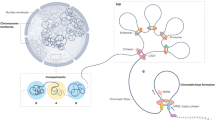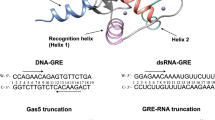Abstract
N-CoR1 and SMRT2 are transcriptional corepressors that associate with nuclear hormone receptors (NRs) in the absence of ligand. This interaction is the molecular target of differentiation therapy for acute promyelocytic leukaemia, wherein retinoic acid dissociates corepressor from leukaemogenic receptor fusion proteins3,4. Binding of ligand to NRs induces a conformation that attracts coactivator proteins containing an Leu-x-x-Leu-Leu motif (the ‘NR box’)5,6. Here we show that N-CoR and SMRT contain sequences that are similar to the NR box and are repeated in each of two NR interaction domains7,8,9,10. We show that this CoRNR (‘corner’) box is required for NR interaction, and that CoRNR box peptides specifically block corepressor interaction in vitro and repression in vivo. Sequences flanking the CoRNR box determine NR specificity. Thus, the key feature of hormone action, differential recognition of unliganded and liganded NRs by coactivators and corepressors, is due to very subtle differences between CoRNR and NR boxes. The molecular mechanisms of repression and activation by NRs are thus linked in an unexpected manner.
This is a preview of subscription content, access via your institution
Access options
Subscribe to this journal
Receive 51 print issues and online access
$199.00 per year
only $3.90 per issue
Buy this article
- Purchase on Springer Link
- Instant access to full article PDF
Prices may be subject to local taxes which are calculated during checkout





Similar content being viewed by others
References
Horlein,A. J. et al. Ligand-independent repression by the thyroid hormone receptor mediated by a nuclear receptor co-repressor. Nature 377, 397–404 (1995).
Chen,J. D. & Evans,R. M. A transcriptional co-repressor that interacts with nuclear hormone receptors. Nature 377, 454–457 (1995).
Lin,R. J. et al. Role of the histone deacetylase complex in acute promyelocytic leukaemia. Nature 391, 811–814 (1998).
Grignani,F. et al. Fusion proteins of the retinoic acid receptor-α recruit histone deacetylase in promyelocytic leukaemia. Nature 391, 815–818 (1998).
LeDourain,B. et al. A possible involvement of TIF1α and TIF1β in the epigenetic control of transcription by nuclear receptors. EMBO J. 15, 6701–6715 (1996).
Heery,D. M., Kalkhoven,E., Hoare,S. & Parker,M. G. A signature motif in transcriptional co-activators mediates binding to nuclear receptors. Nature 387, 733–736 (1997).
Seol,W., Mahon,M. J., Lee,Y.-K. & Moore,D. D. Two receptor interacting domains in the nuclear hormone receptor corepressor RIP13/N-CoR. Mol. Endocrinol. 10, 1646–1655 (1996).
Zamir,I. et al. A nuclear hormone receptor corepressor mediates transcriptional silencing by receptors with different repression domains. Mol. Cell. Biol. 16, 5458–5465 (1996).
Cohen,R. N., Wondisford,F. E. & Hollenberg,A. N. Two separate NCoR (nuclear receptor corepressor) interaction domains mediate corepressor action on thyroid hormone response elements. Mol. Endocrinol. 12, 1567–1581 (1998).
Wong,C. W. & Privalsky,M. L. Transcriptional silencing is defined by isoform and heterodimer-specific interactions between nuclear hormone receptors and corepressors. Mol. Cell. Biol. 18, 5724–5733 (1998).
Wagner,R. L. et al. A structural role for hormone in the thyroid hormone receptor. Nature 378, 690–697 (1995).
Collingwood,T. N. et al. Thyroid hormone-mediated enhancement of heterodimer formation between thyroid hormone receptor β and retinoid X receptor. J. Biol. Chem. 272, 13060–13065 (1997).
Zhang,J., Zamir,I. & Lazar,M. A. Differential recognition of liganded and unliganded thyroid hormone receptor by retinoid X receptor regulates transcriptional repression. Mol. Cell. Biol. 17, 6887–6897 (1997).
Zhang,J., Hu,X. & Lazar,M. A. A novel role for helix 12 of RXR in regulating repression. Mol. Cell. Biol. 19, 6448–6457 (1999).
Schulman,I. G., Juguilon,H. & Evans,R. M. Activation and repression by nuclear hormone receptors: hormone modulates an equilibrium between active and repressive states. Mol. Cell. Biol. 16, 3807–3813 (1996).
Feng,W. et al. Hormone-dependent coactivator binding to a hydrophobic cleft on nuclear receptors. Science 280, 1747–1749 (1998).
Nolte,R. T. et al. Ligand binding and co-activator assembly of the peroxisome prolierator-activated receptor-γ. Nature 395, 137–143 (1998).
Darimont,B. D. et al. Structure and specificity of nuclear receptor–coactivator interactions. Genes Dev. 12, 3343–3356 (1998).
Shiau,A. K. et al. The structural basis of estrogen receptor/coactivator recognition and the antagonism of this interaction by tamoxifen. Cell 95, 927–937 (1998).
Moras,D. & Gronemeyer,H. The nuclear receptor ligand-binding domain: structure and function. Curr. Opin. Cell Biol. 10, 384–391 (1998).
Dressel,U. et al. Alien, a highly conserved protein with characteristics of a corepressor for members of the nuclear hormone receptor superfamily. Mol. Cell. Biol. 19, 3383–3394 (1999).
Zamir,I. et al. Cloning and characterization of a corepressor and potential component of the nuclear hormone receptor repression complex. Proc. Natl Acad. Sci. USA 94, 14400–14495 (1997).
Forman,B. M. et al. Androstane metabolites bind to and deactivate the nuclear receptor CARβ. Nature 395, 612–615 (1998).
Onate,S. A. et al. The steroid receptor coactivator-1 contains multiple receptor interacting and activation domains that cooperatively enhance the activation function 1 (AF1) and AF2 domains of steroid receptors. J. Biol. Chem. 273, 12101–12108 (1998).
Voegel,J. J., Heine,M. J. S., Zechel,C., Chambon,P. & Gronemeyer,H. TIF2, a 160 kDa transcriptional mediator for the ligand-dependent activation fucntion AF-2 of nuclear receptors. EMBO J. 15, 3667–3675 (1996).
McInerney,E. M. et al. Determinants of coactivator LXXLL motif specificity in nuclear receptor transcriptional activation. Genes Dev. 12, 3357–3368 (1998).
Mak,H. Y., Hoare,S., Henttu,P. M. & Parker,M. G. Molecular determinants of the estrogen receptor-coactivator interface. Mol. Cell. Biol. 19, 3895–3903 (1999).
Zamir,I., Zhang,J. & Lazar,M. A. Stoichiometric and steric principles governing repression by nuclear hormone receptors. Genes Dev. 11, 835–846 (1997).
Yoh,S. M., Chatterjee,V. K. K. & Privalsky,M. L. Thyroid hormone resistance syndrome manifests as an aberrant interaction between mutant T3 receptors and transcriptional corepressors. Mol. Endocrinol. 11, 470–480 ().
Acknowledgements
We thank J. Zhang for helpful discussions, and D. Moore for providing VP16-CAR. This work was supported by grants from the National Institute of Diabetes, Digestive and Kidney Diseases of the NIH to M.A.L.
Author information
Authors and Affiliations
Corresponding author
Rights and permissions
About this article
Cite this article
Hu, X., Lazar, M. The CoRNR motif controls the recruitment of corepressors by nuclear hormone receptors. Nature 402, 93–96 (1999). https://doi.org/10.1038/47069
Received:
Accepted:
Issue Date:
DOI: https://doi.org/10.1038/47069
This article is cited by
-
Natural compounds targeting nuclear receptors for effective cancer therapy
Cancer and Metastasis Reviews (2023)
-
Fbxo45 promotes the malignant development of esophageal squamous cell carcinoma by targeting GGNBP2 for ubiquitination and degradation
Oncogene (2022)
-
Persistent COUP-TFII expression underlies the myopathy and impaired muscle regeneration observed in resistance to thyroid hormone-alpha
Scientific Reports (2021)
-
The nuclear receptor 4A family members: mediators in human disease and autophagy
Cellular & Molecular Biology Letters (2020)
-
Circadian oscillator proteins across the kingdoms of life: structural aspects
BMC Biology (2019)
Comments
By submitting a comment you agree to abide by our Terms and Community Guidelines. If you find something abusive or that does not comply with our terms or guidelines please flag it as inappropriate.



